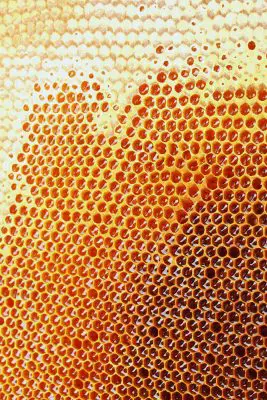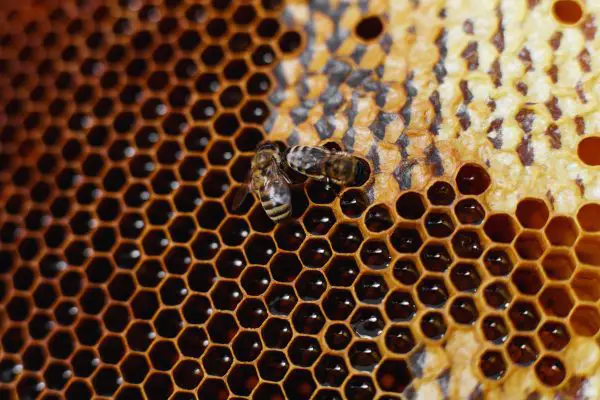Due to excessive moisture inside the hive, molds may build within frames. It might make you sad when you go to extract honey and find lots of molds in the frames. What should you do in such a situation is this post’s primary purpose.
A few years ago, I discovered bee traffic around my hive was gradually decreasing. Then one day I discovered that bees had lifted the hive.
I didn’t find any sign of disease inside the hive. So, I decided to reuse the abandoned beehive. Before reusing it, I was hoping to extract honey from it. But discovered molds have grown and covered the caped honey.
I was not sure if it was safe to extract honey from those moldy frames. Then my instructor beekeeper helped me to overcome the situation. That’s what I will discuss with you.
So, the following things you will get to know after reading this blog post.
- Detailed answer to your question “Can you harvest honey with mold on the frames?”.
- What to do with the frame having mold on it?
- How to prevent mold build up inside the beehive.
How Molds Start To Build Up On Frames
The main reason that starts building mold is excess moisture. If your bees are unable to produce enough heat inside the hive moisture may grow up. With the increase of moisture mold build-up will also increase on frames.

Fungi are responsible for building molds within frames. These molds can be white, grey, or yellow, It is totally a common phenomenon for beehives. Honeybees are familiar with how to remove molds from beehives.
So, if the mold has just started to grow up honey bees will clean it on their own. Because they give higher priority to reusing the same frames. So, they can handle frames having small molds.
When there is excessive moisture in your hive bees might not be able to clean molds from frames. Because they are having a worse time providing ventilation inside the hive. So, the molds will be an extra unwanted problem for them.
In such cases, bees might swarm away or an entire hive might die. So, you can understand molds in hive is common but excessive mold can be harmful sign. Excessive molds mean excessive moisture inside the hive.
There can be other reasons behind molds starting to build up in frames. The following are the possible reasons for molds on frames.
- Excess moisture inside the hive.
- Poor Ventilation mechanism.
- American Foulbrood or such kind of bacterial infection.
- Infection by other honey bee diseases.
- Having extra super inside the hive.
- Having mite infection.
Can You Harvest Honey With Mold On The Frames
It is preferred not to harvest honey with mold on the frames. First, you have to remove the molds and then you can harvest honey on those frames. If the molds are not hard you can remove them using the honey extraction knife.

In my case, there were several reasons behind mold growing on the frames. First of all, I have placed 3 honey super before winter. Which was worse for them. I also discovered there was a mite infection inside the hive.
The extra super was found almost empty. This super causes the problem because it forces the worker to work more and it also takes more space.
So, the worker was having a tough time before winter to collect extra honey. Also, during winter they were having difficulties producing sufficient heat.
As a result, molds were grown up. Whatever after the winter I have extracted honey that was left by the swarm.
As there was mold on the frames, I had to go through a process for extracting honey from those moldy frames.
How To Extract Honey From Moldy Frames
I have extracted honey from those moldy frames according to my instructor.

For this, I followed the steps below.
- I have taken moldy frames out of the hive.
- Then first I placed them in the sunlight.
- Extra moisture has been removed and mold growth has been stopped.
- I also saw that molds start melting.
- Then using the knife I removed the molds from the frames.
- I have reused 3 of those frames full of honey for a new nuc.
- The remaining frames that I was hoping to extract honey is stored in a honey-warming cabinet for 1 week.
- Then I extracted honey from those frames after removing the molds.
- Then I sterilized the honey and consumed it by myself and for my family.
Is It Safe To Eat Such Honey
I have consumed the honey extracted from the moldy frames. It didn’t cause any infection to me and my family members. But it was seen that the quality of the honey became lower. Also, the taste also degraded.
Molds in frames are totally common inside beehives. After removing those molds and sterilizing the honey is safe to consume. However, its nutrients may degrade during the sterilizing process.
What To Do With Moldy Frames
The best thing you can do with moldy frames is to reuse them. Let the frames dry out and then place them inside strong colonies. If you have multiple moldy frames you may place them in multiple beehives.
You will reuse a moldy frame only if its foundation is in good shape and reusable.
In my case, I have used those 3 frames for starting a completely new colony. I have seen so many dead bees covered by the molds.
I was thinking are these molds responsible for the death of those bees? Then I discovered these bees died because of mite attacks not for the molds. Also, during mite treatments I have used Oxalic Acid (OA) wash.
Due to the excessive use of OA, a lot of bees have died. And molds are not responsible for their death.
So, I let the moldy frames dry out. Then I removed dead bees from these frames using needles. Then I used a new nuc and transferred them to that abandoned beehive. I placed these 3 frames inside this hive.
After a few days, I saw the bees already cleaned those molds from the frames. Also, they started to store more honey.
So, by reusing moldy frames you can start a new colony. This will provide food storage for the bees. They will clean the molds. Also, this will be a good way to kick off their colony.
If you don’t want to build a new colony you can merge them with other colonies. If you have 1 or 2 moldy frames merge them with any of your existing strong colonies. If you have a large number of frames then place them in different beehives.
But before reusing moldy frames you should dry out them. Also, try to remove dead bees and waste from those frames.
How To Prevent Molds Build Up Inside Hive
Having mold inside the hive is totally a common phenomenon. If you discover a small amount of molds started to build within frames, don’t panic. Your bees will clean them up soon.

But if you see a continuous increase of mold on frames then it could be a matter of worry. There could be several reasons behind this. First of all, you have to figure out the exact reason behind it. Then take the necessary steps to solve it.
Excessive moisture inside the hive, overpopulated colony, abandoned hive, and so many more phenomena can cause molds to build up on frames. So, the first priority is to ensure proper ventilation inside the hive.
Here are some tips that might be helpful for you to stop excessive molds inside the hive.
- Ensure Proper Ventilation: It should be the first priority to prevent mold from growing inside the hive. If there is poor ventilation molds and disease inside the hive will easily start to grow. You can use a moisture board or quilt box to provide proper ventilation during winter.
- Winterizing Hive: Before the winter all beekeepers need to take some steps to winterize a beehive. You should also do so before the winter.
- Don’t Use Chemicals: Without proper knowledge, it is better not to use any pesticides in your beehive. You should consult with a specialist for mites and other treatments for your hive. You can use essential oils like lemongrass oil inside your beehive for various purposes instead of chemicals.
- Split and Merge Poor Colony: If you have a weak or overpopulated colony split it and merge with another strong colony.
- Careful About Mite Treatment: During Mite treatment don’t use excessive Oxalic acids. Consult with an expert beekeeper or pest control specialist before applying.
- No Extra Moisture No Molds: You should ensure there is no extra moisture. Enough heat and dry colony won’t have much mold on frames.
- Inspect Less During Winter: Inspecting the hive often during winter may cause excessive moisture inside the hive. So, you should inspect less during this season. Also, you shouldn’t open your hive during bad weather conditions.
Remember you can harvest honey with mold on the frames if you do it with the appropriate process. It is always suggested to reuse moldy frames with other colonies or to start a new colony. However, less amount of molds is totally normal. Don’t get panicked.
If you need help contact your local beekeepers who have experience with it. You can also contact with us. I will be pleased to help you to solve the problem.
Now you can check out another article on how much beekeeping costs for beginners.
Frequently Asked Questions
Can you eat moldy honeycomb?
You can eat moldy honeycomb if you remove the molds first. Let the moldy comb in a warmer place. Let the comb dry out. If possible remove dark molds. Then it is ready to consume.
Will mold hurt honey bees?
Absolutely not. Molds can be built over honey frames but it doesn't hurt them. Honey bees are also capable of removing these molds on their own.
What is the white stuff in my honeycomb?
They are probably molds. Because inside beehive molds can be grown up due to extra moisture. Molds can be white, yellow, and bluish.
Why does honey go Moldy?
Honey is produced through a fermentation process from pollen and nectar collected by bees. If there was moisture then bacteria or fungi may start to grow. As a result, honey may become moldy.
Regards
Beekeepingstudy


